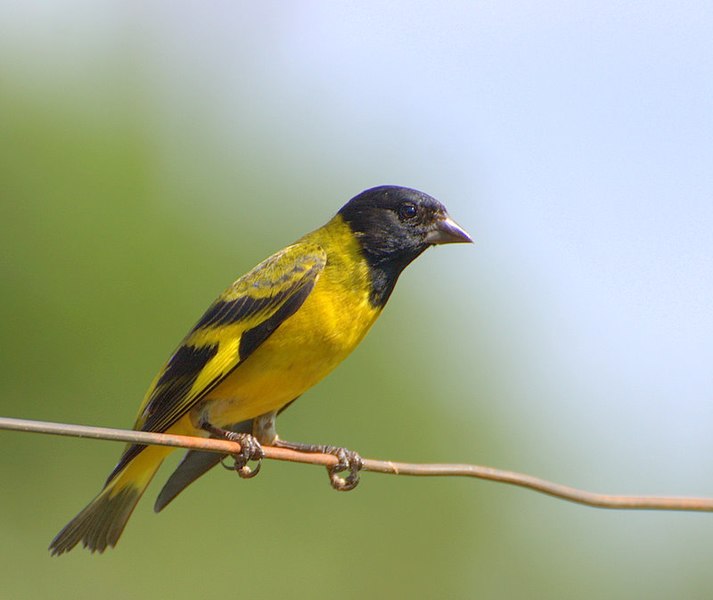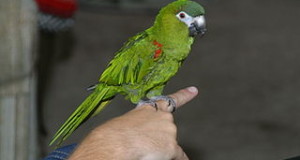 Although we are fortunate to have available a wide variety of commercial finch and canary diets, choosing one can be a difficult task. Once a decision is made as to the basic type – seed or pellet – we must then consider the ingredients, which vary from brand to brand. Today I’ll examine some well-known foods and a few often-neglected dietary supplements.
Although we are fortunate to have available a wide variety of commercial finch and canary diets, choosing one can be a difficult task. Once a decision is made as to the basic type – seed or pellet – we must then consider the ingredients, which vary from brand to brand. Today I’ll examine some well-known foods and a few often-neglected dietary supplements.
Basic Guidelines
It’s important to remember that finch species vary in their nutritional needs. While many will thrive on the basic diets described below, to achieve optimal health and color the addition of insects, sprouts, fruit, greens and other supplementary foods will be necessary. Depending upon the species, some of these foods can also be used to bring birds into breeding condition. Please post your questions concerning diets for specific finches below, and I’ll provide some suggestions.
Pellet Diets
Pellet-based diets have achieved popularity among parrot keepers and in zoos, but are less commonly used for finches. Their main advantage lies in the fact that birds are prevented from selecting favorite items, as can be done when a variety of seeds is offered. Assuming the product is well-made, birds on pellet diets may consume a more complete diet than those relying upon seeds. Unfortunately, finches are often slow to take pellets. Fruit flavors are commonly used to encourage acceptance.
ZuPreem Fruit Blend Canary and Finch Food
This well-researched pellet offers excellent nutrition and is enriched with 21 vitamins and minerals. Grapes, bananas and oranges, which are favored by many finches, are used to flavor the pellets.
Kaytee Exact Rainbow for Canaries and Finches
Kaytee pellets include dried beet pulp, which may enhance certain feather colors, along with whole eggs for additional protein.
Zoo Vital Canary and Finch Food
 This product is unique in that it contains 5 strains of probiotic bacteria, which may increase digestibility. Bananas, pineapple and papaya add additional nutrients and flavor.
This product is unique in that it contains 5 strains of probiotic bacteria, which may increase digestibility. Bananas, pineapple and papaya add additional nutrients and flavor.
Seed Diets
Seed-based diets have been in use for hundreds of years, and are still the most common foods for captive finches and canaries. While individual species’ needs differ, a wide variety of ingredients (in addition to the basics – i.e. various millets, canary grass seed) should be included.
L&M Bonanza Canary and Finch Gourmet Diet
Fifteen different seeds, grains and dried fruits and vegetables assure birds a variety of beneficial nutrients. Extra vitamins and minerals are also included, so check the ingredients against any supplements you might use to avoid overlap.
Pretty Bird Premium Food for Canaries and Finches
This diet includes 10 seed varieties and was formulated to meet the high energy demands and fiber requirements of most finches. Dried fruits and vegetables are not included.
Vitakraft’s Sunseed Vita for Finches
Nigerthistle and 9 other seeds, along with dried pineapple, carrot, papaya, coconut and apples, ensure good basic nutrition for most species.
Supplementary Foods
Millet sprays are 8-10 inch long stems with seeds attached, which can be hung from cage bars, perches and toys. All finches and canaries enjoy millet, but the real value of sprays is the exercise and enrichment they provide. Birds typically become very excited when presented with sprays, much more so than when feeding from a bowl.
 Egg Food (whole dried eggs, vegetable protein, and oats) is an ideal way of meeting your birds’ protein requirements. Protein is not given much attention in finch diets, but is especially important at molting time and during the breeding season.
Egg Food (whole dried eggs, vegetable protein, and oats) is an ideal way of meeting your birds’ protein requirements. Protein is not given much attention in finch diets, but is especially important at molting time and during the breeding season.
This food is intended as a staple diet for toucans, mynas,Pekinrobins and other softbills, but serves well as a supplementary food for finches and canaries. I used softbill pellets as an “insurance item” in the diets of a great many seed-eating birds under my care at the Bronx Zoo. Softbill Select is a soft pellet that contains 12 fruits and vegetables, including spinach, broccoli, dates, sweet potatoes and others that are not commonly included in finch diets.
Further Reading
Avicultural Journal: Lesser-known seeds for finches
Balanced Diets for FinchesInteresting perspective from a breeder
Feeding Finches: Tips and Special Considerations
Double-barred Finch image referenced from wikipedia and originally posted by DickDaniels
Wedge-tailed Grass Finch and Hooded Siskin images referenced from wikipedia and originally posted by Dario Sanchez
 That Bird Blog – Bird Care and History for Pet Birds
That Bird Blog – Bird Care and History for Pet Birds




Hello Frank, and thank you for the reply.
I decided to post my question here since there’s no other comments.
So, continuing the topic of plant choices, have you any experience with pothos ivy (scindapsus)? Many websites have said they are safe for birds, I just want to be sure…
Also, I agreed with you, perhaps I should seek or make a shelter with windbreak… For them to sleep in peace.
Oh yeah, I live in the warm tropics.
Thanks so much Frank!
HI Raymond,
Thanks. Pothos is safe, and a good choice. Leaves and stems are tough on large, well-established plants; will grow in vine form, can use form windbreaks and such near your shelter; doesn’t need bright sun although it will grow faster if well-lit. Very hardy also, I grow it right in water in some exhibits.
Best, Frank